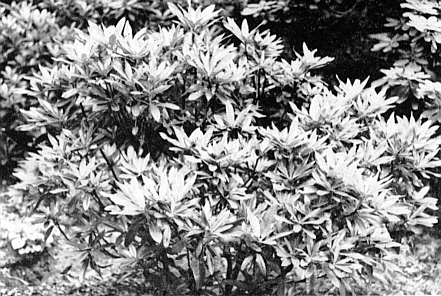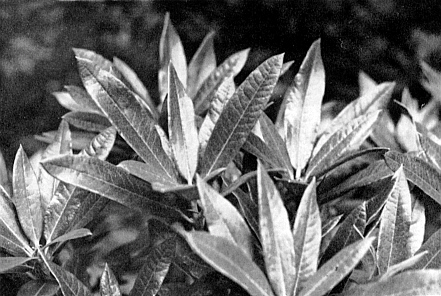QBARS - v23n4 Will Someone Please Help?
Will Someone Please Help?
Carl H. Phetteplace, M.D.
The following may only show the enormity of my ignorance about the genus Rhododendron , but until this spring I was not aware that there was an elepidote Rhododendron species with aromatic foliage. As noted in a previous communication*,
*Quarterly Bulletin of the A.R.S., Vol. 21, No. 2, April 1967.
I have been growing a number of plants from the 1948-49 Joseph Rock expedition. There was one small plant upon which there never was a metal tag showing its number, as there was supposed to be on all of them. I have grown this plant now for 20 years with no idea at all of what it was. For some time, however, I have noticed that in walking by a certain section of the garden on a favorable day the air was filled with a delightful fragrance. The best I could do to describe it is that it is somewhat like the odor of tea but much more "sweet" and delicate. For a time I had ignored this, but finally this year it was so striking and pleasing that I paused to look for its source. I quickly came to this plant, which is now a good four feet tall and perhaps wider than tall, very compact and generally attractive.
It had its first truss this year, consisting of 16 ivory white flowers, very compact and neat. I did not have time just then to make a very detailed inspection of it, but did hand pollinate it. I believe it was five-lobed. I think there was no fragrance to the flowers but at almost any favorable time one can get the delightful fragrance of the leaves from as far away as 10 or 15 feet.

|
|
|||
|---|---|---|---|---|
Fig. 75. A picture of the whole Rock plant - un-numbered, which has the fragrant foliage. Dr. Phetteplace photo |
||||

|
||||
Fig. 76. A close up picture of the un-numbered Rock plant with the fragrant foliage. Dr. Phetteplace photo |
The leaves are narrowly elliptical, seven to fourteen centimeters in length and two to three centimeters in width. They are quite glossy on the upper surface, with a depressed midrib and twelve to sixteen lateral veins which are only slightly depressed. Despite this glossy appearance of the upper surface, on examining it with the lens there are numerous small tufts of brown hair situated principally in the grooves of the veins and midrib. In the young leaves there is a pale, thin, rather tightly plastered greenish indumentum on the under surface, through which can be seen small islets of darker green when examined under the lens. The indumentum becomes slightly brown on the older foliage but still presents the small green islets under magnification. Few leaves stay on longer than two years, and the older ones lose much of the indumentum, especially along the outer margins. The base of the leaves tapes in almost the same shape as the pointed extremity, to end in a petiole about one and one-half centimeters in length, which is very slightly grooved on the top halfway down and then becomes perfectly round. The tufts of brown hairs persist on this petiole as well.
The capsule, which is now slightly over one centimeter in length, has not been dissected because I wish to save as much seed for the Exchange as possible. It seems to have six compartments and is studded with myriads of small structures, which I believe to be glands when I view them under the lens.
For a time I thought this was the only elepidote plant with fragrant foliage, but in sniffing around the garden I find another Rock plant. Unfortunately the explorer number on it has also been lost. It seems on close contact to be even more fragrant than the one above described, and of exactly the same type of aroma. The leaves are very similar in appearance and shape superficially as the first plant described but this plant, now over twenty years old, is only eighteen inches tall and has never flowered. If anything, its leaves are slightly larger than the larger plant. There is a difference in the indumentum. First, it is slightly heavier on the small plant and is of a very faint tan color the first year. On examining it with the lens it seems to be a thick, tight network of silky hairs woven together and is not quite so plastered as the former one. The leaves on this plant are persistent for four or five years, steadily becoming first a light brown and then the very old leaves becoming almost black, I think partially due to the splash of soil from heavy rains. I am quite convinced that the fragrance on both these plants emanates from the indumentum and not from the upper surface of the leaves.
I have asked a number of rhododenologists who have passed through the garden from time to time to try to identify nearly all of the Rock plants that I possess. Almost without exception they have agreed that these two plants belong to the Taliense series, but that is as close as anyone seems to voice an opinion with much confidence. Mr. Euan Cox saw these plants approximately nine years ago and thought there was a possibility that the larger plant might be R. elegantulum . In the R. H .S. Yearbook it states that this species is not known for sure to be in cultivation and more information about it is requested by the editor. However in the Species Book, edited by Mr. Stevenson, there is a description of it under Subseries adenogynum that does not quite fit the plant I have described. The smaller plant, Mr. Cox has ventured, could be R. recurvoides . But in both instances I am quite sure he offered these suggestions merely as a good guess and not as an authoritative opinion.
Both of these plants are a delight in my garden, and how I do wish I could live another twenty or thirty years until they became somewhat mature and showed to us all of their virtues. We all know the commonness of aromatic foliage in lepidotes but to me such a delightful bouquet from an elepidote, not in flower, is quite singular. I have sniffed around a number of other Taliense series rhododendrons in my garden and have found none with the slightest odor.
I wonder if someone could please help to solve what is to me really a mystery. These plants are so delightful month after month, now that I know the source of this sweet aroma, that I cannot pass without putting my face into the bush and taking a few whiffs. These are plants that even a blind man could enjoy. What have we here?


